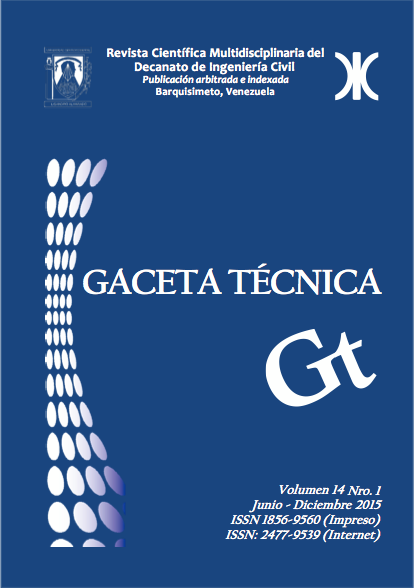Earthquake-resistant behavior of three mid-rise buildings designed according venezuelan seismic codes
DOI:
https://doi.org/10.13140/RG.2.1.5031.7687Keywords:
composite structures, damage models, dynamic analysisAbstract
Here is presented a study on the seismic vulnerability of three mid-rise structural models projected according to Venezuelan seismic code Covenin 1756-01. Models have similar structural configurations in plant and in inter-story heights. Seismic action uses hybrid accelerograms compatible with the design spectrum characteristic of the metropolitan area Barquisimeto-Cabudare. Damage Evaluation is made through fragility curves and damage indices, including probabilistic approach. Some models showed high probability of severe damage or collapse, suffering significant stiffness degradation and lateral deformations beyond normative limits, showing that relative displacements and stiffness degradation are fundamental indicators for structural damage. It is concluded that to evaluate the behavior of the analyzed structural models subjected to probable seismic action, it ́s required a detailed study of the horizontal displacements, particularly relative displacements between levels and that the provisions of the Venezuelan seismic code may not be sufficient for evaluating the seismic performance of these models
Downloads
References
[2] W. Li, Q. Li, W.Jiang y L. Jiang. “Seismic performance of composite reinforced concrete and steel moment frame structures–state-of-the-art”. Composites: Part B 42 (2011) 190–206. Doi.org/10.1016. 2011.
[3] R. Melchers. “Structural Reliability Analysis & Prediction”. Wiley Inc. New York, 2002.
[4] HAZUS-99. “Earthquake Loss Estimation Methodology”. Technical Manual Vol 1. Federal Emergency Management Agency (FEMA). Washington. 1999.
[5] Z. Milutinovic y G. Trendafolosky. “WP04 Vulnerability of current buildings”. RISK- UE Project. Bruselas, 2003.
[6] S. Freeman. “Development and use of capacity spectrum method”. Proceedings of 6th U.S. National Conference on Earthquake Engineering. 1998.
[7] ATC 40. “Improvement of nonlinear static seismic analysis procedures”. Applied Technology Council (ATC). Report No. FEMA-440, Washington, DC, 2005.
[8] D. Vamvatsikos y A. Cornell. “Incremental dynamic analysis”. Earthquake Engineering and Structural Dynamics 2002; 31:491–514. 2002.
[9] L. Pujades, Y. Vargas, A. Barbat y J. González. “Parametric model for capacity curves”. Bulletin of Earthquake Engineering. (Published online 13.sept. 2014). DOI 10.1007/s10518-014-9670-5. 32 p. 2014.
[10] COVENIN 1756:01. “Edificaciones sismo resistentes”. FondoNorma. Caracas. 2001.
[11] M. Schmitz, J.J. Hernández, C. Morales y otros. “Proyecto de Microzonificación Sísmica en las ciudades de Caracas y Barquisimeto”. FONACIT. Informe Técnico Final. Volumen 1. Caracas. FUNVISIS. 2009.
[12] F. López-Almansa, y A. Benavent. “Vulnerability Analysis of RC buildings located in moderate seismic regions”. Engineering Structures, Vol.46 pp 687-702. 2013.
[13] SEAOC. “Vision 2000. A framework for performance-based engineering”. Structural Engineers Association of California, Sacramento, CA. 1995.
[14] R. Ugel. “Vulnerabilidad sísmica en edificaciones porticadas compuestas de acero y hormigón armado”. Tesis Doctoral. Departamento de Ingeniería del Terreno, Cartográfica y Geofísica. Universidad Politécnica de Catalunya. Barcelona, España. 2015.
[15] R. Ugel, R. Herrera, A. Dorante y M. Machado. “Análisis y Respuesta Sismo- Resistente en Edificaciones Aporticadas Compuestas ubicadas en Barquisimeto”. Memorias del II Congreso Internacional de Ingeniería Estructural & Sismorresistente. Valencia, 2014
[16] COVENIN 2002-1988. “Criterios y Acciones Mínimas para el Proyecto de Edificaciones”. FondoNorma, Caracas.1988.
[17] C. Bhatt y R. Bento. “The extended adaptive capacity spectrum method for the seismic assessment of plan asymmetric buildings”. Earthquake Spectra. doi:10.1193/022112EQS048M. 2013
[18] R. Pinho, M. Marques, R. Monteiro y C. Casarotti. “Using the adaptive capacity spectrum method for seismic assessment of irregular frames”. In: Proceedings 5th European workshop on the seismic behaviour of irregular and complex structures, Italy. 2008
[19] COVENIN 1753-2006. “Proyecto y construcción de obras en concreto estructural”. FondoNorma. Caracas. 2006.
[20] M. Menegotto y P. Pinto. “Method of analysis for cyclically loaded R.C. plane frames including changes in geometry and non-elastic behaviour of elements under combined normal force and bending”. Symposium: Resistance and Ultimate Deformability of Structures Acted on by Well Defined Repeated Loads. Zurich, Switzerland, pp. 15-22. 1973.
[21] F. Filippou, E. Popov y V. Bertero. “Effects of Bond Deterioration on Hysteretic Behavior of Reinforced Concrete Joints”. Report EERC 83-19, Earthquake Engineering Research Center, University of California, Berkeley. 1983.
[22] J. Mander, N. Priestley y R. Park. “Observed stress-strain behavior of confined concrete”. Structural Engineering, ASCE, 114(8), 1827-1849. 1988.
[23] SEISMOSOFT. “SeismoStruct. A Computer Program for Static and Dynamic Nonlinear Analysis of Framed Structures”. Available from: http://www.seismosoft.com. 2014.
[24] S. Antoniou y R. Pinho. “Advantages and limitations of adaptive and non-adaptive force-based pushover procedures”. Jour. of Earthq. Engineering, Vol. 8 No. 4. pp 497/522. 2004.
[25] FEMA. National Earthquake Hazards Reduction Program. “Improvement of non linear static seismic analysis procedures”. Applied Technology Council (FEMA 440). ATC- 55 Project. 201 Redwood Shores Parkway, Suite 240 Redwood City, California, 2005.
[26] A. Mwafy y A. Elnashai. “Calibration of Force Reduction Factors of RC Buildings”. Journal of Earthquake Engineering, 6: 2, 239 - 273. 2002.
[27] V. Papanikolau y A. Elnashai. “Evaluation of conventional and adaptive pushover analysis I: Methodology”. Journal of Earthquake Engineering, 9: 6, 923- 941. 2005
[28] A. Chopra y R. Goel. “A modal pushover analysis procedure for estimating seismic demands for unsymmetric-plan buildings”. Earthquake Engineering and Structural Dynamics 2004; 33(8):903–927. 2004.
[29] PEER. NGA Database. “Pacific Earthquake Engineering Research Center”. CEE 227 – Earthquake Engineering. University of California. Berkeley. UC Regents. 2013.
[30] G. Calvi. “Alternative Choices and Criteria for Seismic Strengthening”. Proceedings in 15th World Conference Earthquake Engineering. Lisbon, Portugal. 2012.
[31] EUROPEAN COMMITTEE OF NORMALIZATION. “Design of structures for earthquake resistance—part 3: assessment and retrofitting of buildings. European Standard EN 1998–3 Eurocode 8”. Brussels, 2005.
[32] L. Pujades, A. Barbat y N. Lantada. “Evaluación del riesgo sísmico en zonas urbanas: desarrollo de escenarios”. Revista internacional de Ingeniería de Estructuras. Vol. 12, 1. 1 – 28. ISSN 1390-0315. ESPE, Quito – Ecuador. 2007.
[33] A. Ang, W. Kim y S. B. Kim. “Damage estimation of existing bridge structures”. Technical Report, Structural Engineering in Natural Hazards. Vol. II. John Wiley and Sons, New York. ASCE Structures Congress. Irivine. California. 1993.
[34] EUROPEAN COMMITTEE OF NORMALIZATION. “Eurocode 8: design of structures for earthquake resistance. Part 1: general rules, seismic actions and rules for buildings”. Brussels, 1998.
[35] C. Bermúdez. “Vulnerabilidad sísmica de edificios de acero”. Tesis Doctoral. Departamento de Ingeniería del Terreno, Cartográfica y Geofísica. Universidad Politécnica de Catalunya. España. 2010.
[36] M. Gunay y H. Sucuoglu. “An improvement to linear-elastic procedures for seismic performance assessment”. Earthquake Engineering and Structural Dynamics. Published online in Wiley InterScience. DOI: 10.1002/eqe.980. 2011.
Published
How to Cite
Issue
Section
The opinions expressed by the authors do not necessarily reflect the position of the editor of the publication or UCLA. The total or partial reproduction of the texts published here is authorized, provided that the complete source and electronic address of this journal is cited. Authors have the right to use their articles for any purpose as long as it is done nonprofit. The authors can post on the internet or any other media the final approved version of their work.







.png)




